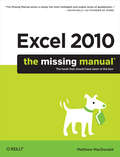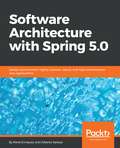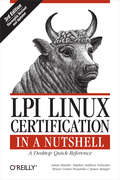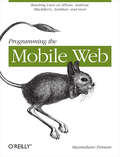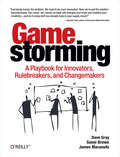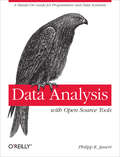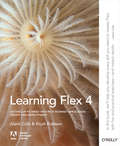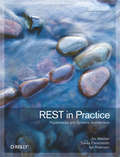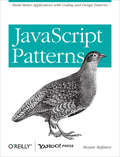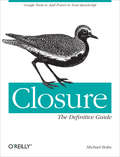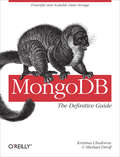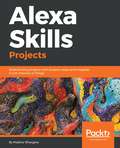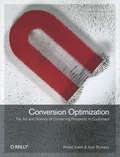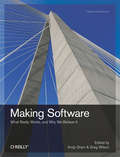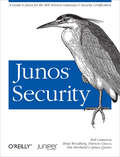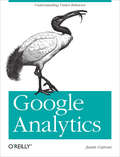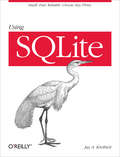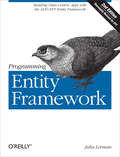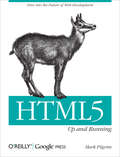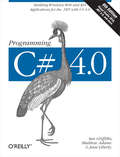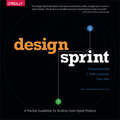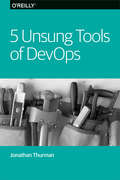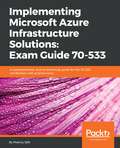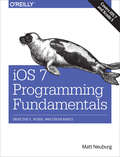- Table View
- List View
Excel 2010: The Missing Manual (The\missing Manual Ser.)
by Matthew MacdonaldExcel, the world's most popular spreadsheet program, has the muscle to analyze heaps of data. Beyond basic number-crunching, Excel 2010 has many impressive features that are hard to find, much less master -- especially from online help pages. This Missing Manual clearly explains how everything works with a unique and witty style to help you learn quickly. Navigate with ease. Master Excel's tabbed toolbar and its new backstage view Perform a variety of calculations. Write formulas for rounding numbers, calculating mortgage payments, and more Organize your data. Search, sort, and filter huge amounts of information Illustrate trends. Bring your data to life with charts and graphics -- including miniature charts called Sparklines Examine your data. Summarize information and find hidden patterns with pivot tables and slicers Share your spreadsheets. Use the Excel Web App to collaborate with colleagues online Rescue lost data. Restore old versions of data and find spreadsheets you forgot to save
Software Architecture with Spring 5.0: Design and architect highly scalable, robust, and high-performance Java applications
by Alberto Salazar René EnríquezDiscover how different software architectural models can help you solve problems, and learn best practices for the software development cycleKey FeaturesLearn concepts related to software architecture and embrace them using the latest features of Spring 5Discover architectural models and learn when to apply themGain knowledge of architectural principles and how they can be used to provide accountability and rationale for architectural decisionsBook DescriptionSpring 5 and its ecosystem can be used to build robust architectures effectively. Software architecture is the underlying piece that helps us accomplish our business goals whilst supporting the features that a product demands. This book explains in detail how to choose the right architecture and apply best practices during your software development cycle to avoid technical debt and support every business requirement. Choosing the right architecture model to support your business requirements is one of the key decisions you need to take when a new product is being created from scratch or is being refactored to support new business demands. This book gives you insights into the most common architectural models and guides you when and where they can be used. During this journey, you’ll see cutting-edge technologies surrounding the Spring products, and understand how to use agile techniques such as DevOps and continuous delivery to take your software to production effectively. By the end of this book, you’ll not only know the ins and outs of Spring, but also be able to make critical design decisions that surpass your clients’ expectations.What you will learnUnderstand the key principles of software architectureUncover the most common architectural models availableAnalyze scenarios where an architecture model should be usedImplement agile techniques to take your software to production Secure the products you are working onMaster tricks that will help you build high-performant applicationsUse cutting-edge technologies to build productsWho this book is forIf you’re an experienced Spring developer aspiring to become an architect of enterprise-grade applications, this book is for you. It’s also ideal for software architects who want to leverage Spring to create effective application blueprints.
LPI Linux Certification in a Nutshell: A Desktop Quick Reference (In A Nutshell (o'reilly) Ser.)
by James Stanger Bruno Gomes Pessanha Adam Haeder Stephen Addison SchneiterLinux deployment continues to increase, and so does the demand for qualified and certified Linux system administrators. If you're seeking a job-based certification from the Linux Professional Institute (LPI), this updated guide will help you prepare for the technically challenging LPIC Level 1 Exams 101 and 102. The third edition of this book is a meticulously researched reference to these exams, written by trainers who work closely with LPI. You'll find an overview of each exam, a summary of the core skills you need, review questions and exercises, as well as a study guide, a practice test, and hints to help you focus. Major topics include: Critical GNU and Unix commands Linux installation and package management Devices and filesystems Text editing, processing, and printing The X Window System Networking and security Mail transfer agents Email, FTP, and web services These exams are for junior to mid-level Linux administrators with about two years of practical system administration experience. You should be comfortable with Linux at the command line and capable of performing simple tasks, including system installation and troubleshooting.
Programming the Mobile Web
by Maximiliano FirtmanToday's market for mobile apps goes beyond the iPhone to include BlackBerry, Nokia, Windows Phone, and smartphones powered by Android, webOS, and other platforms. If you're an experienced web developer, this book shows you how to build a standard app core that you can extend to work with specific devices. You'll learn the particulars and pitfalls of building mobile apps with HTML, CSS, and other standard web tools.You'll also explore platform variations, finicky mobile browsers, Ajax design patterns for mobile, and much more. Before you know it, you'll be able to create mashups using Web 2.0 APIs in apps for the App Store, App World, OVI Store, Android Market, and other online retailers.Learn how to use your existing web skills to move into mobile developmentDiscover key differences in mobile app design and navigation, including touch devicesUse HTML, CSS, JavaScript, and Ajax to create effective user interfaces in the mobile environmentLearn about technologies such as HTML5, XHTML MP, and WebKit extensionsUnderstand variations of platforms such as Symbian, BlackBerry, webOS, Bada, Android, and iOS for iPhone and iPadBypass the browser to create offline apps and widgets using web technologies
Gamestorming: A Playbook for Innovators, Rulebreakers, and Changemakers (O'reilly Ser.)
by James Macanufo Sunni Brown Dave GrayGreat things don't happen in a vacuum. But creating an environment for creative thinking and innovation can be a daunting challenge. How can you make it happen at your company? The answer may surprise you: gamestorming. This book includes more than 80 games to help you break down barriers, communicate better, and generate new ideas, insights, and strategies. The authors have identified tools and techniques from some of the world's most innovative professionals, whose teams collaborate and make great things happen. This book is the result: a unique collection of games that encourage engagement and creativity while bringing more structure and clarity to the workplace. Find out why -- and how -- with Gamestorming. Overcome conflict and increase engagement with team-oriented games Improve collaboration and communication in cross-disciplinary teams with visual-thinking techniques Improve understanding by role-playing customer and user experiences Generate better ideas and more of them, faster than ever before Shorten meetings and make them more productive Simulate and explore complex systems, interactions, and dynamics Identify a problem's root cause, and find the paths that point toward a solution
Data Analysis with Open Source Tools: A Hands-On Guide for Programmers and Data Scientists
by Philipp K. JanertCollecting data is relatively easy, but turning raw information into something useful requires that you know how to extract precisely what you need. With this insightful book, intermediate to experienced programmers interested in data analysis will learn techniques for working with data in a business environment. You'll learn how to look at data to discover what it contains, how to capture those ideas in conceptual models, and then feed your understanding back into the organization through business plans, metrics dashboards, and other applications. Along the way, you'll experiment with concepts through hands-on workshops at the end of each chapter. Above all, you'll learn how to think about the results you want to achieve -- rather than rely on tools to think for you. Use graphics to describe data with one, two, or dozens of variables Develop conceptual models using back-of-the-envelope calculations, as well as scaling and probability arguments Mine data with computationally intensive methods such as simulation and clustering Make your conclusions understandable through reports, dashboards, and other metrics programs Understand financial calculations, including the time-value of money Use dimensionality reduction techniques or predictive analytics to conquer challenging data analysis situations Become familiar with different open source programming environments for data analysis "Finally, a concise reference for understanding how to conquer piles of data." --Austin King, Senior Web Developer, Mozilla "An indispensable text for aspiring data scientists." --Michael E. Driscoll, CEO/Founder, Dataspora
Learning Flex 4: Getting Up to Speed with Rich Internet Application Design and Development (Adobe Developer Library)
by Elijah Robison Alaric ColeLearn Adobe Flex 4 in a fun and engaging way with this book's unique, hands-on approach. Using clear examples and step-by-step coaching from two experts, you'll create four applications that demonstrate fundamental Flex programming concepts. Throughout the course of this book, you'll learn how to enhance user interaction with ActionScript, and create and skin a user interface with Flex's UI components (MXML) and Adobe's new FXG graphics format. You'll also be trained to manage dynamic data, connect to a database using server-side script, and deploy applications to both the Web and the desktop. Learning Flex 4 offers tips and tricks the authors have collected from years of real-world experience, and straightforward explanations of object-oriented programming concepts to help you understand how Flex 4 works. Work with Flash Builder 4 and the Eclipse IDE Learn the basics of ActionScript, MXML, and FXG Design a Flex application layout Build an engaging user interface Add interactivity with ActionScript Handle user input with rich forms Link Flex to a server with PHP and MySQL Gather and display data Style applications and add effects, filters, and transitions Deploy applications to the Web, or to the desktop using Adobe AIR
REST in Practice: Hypermedia and Systems Architecture
by Ian Robinson Savas Parastatidis Jim WebberWhy don't typical enterprise projects go as smoothly as projects you develop for the Web? Does the REST architectural style really present a viable alternative for building distributed systems and enterprise-class applications? In this insightful book, three SOA experts provide a down-to-earth explanation of REST and demonstrate how you can develop simple and elegant distributed hypermedia systems by applying the Web's guiding principles to common enterprise computing problems. You'll learn techniques for implementing specific Web technologies and patterns to solve the needs of a typical company as it grows from modest beginnings to become a global enterprise. Learn basic Web techniques for application integration Use HTTP and the Web's infrastructure to build scalable, fault-tolerant enterprise applications Discover the Create, Read, Update, Delete (CRUD) pattern for manipulating resources Build RESTful services that use hypermedia to model state transitions and describe business protocols Learn how to make Web-based solutions secure and interoperable Extend integration patterns for event-driven computing with the Atom Syndication Format and implement multi-party interactions in AtomPub Understand how the Semantic Web will impact systems design
JavaScript Patterns: Build Better Applications with Coding and Design Patterns
by Stoyan StefanovWhat's the best approach for developing an application with JavaScript? This book helps you answer that question with numerous JavaScript coding patterns and best practices. If you're an experienced developer looking to solve problems related to objects, functions, inheritance, and other language-specific categories, the abstractions and code templates in this guide are ideal -- whether you're writing a client-side, server-side, or desktop application with JavaScript. Written by JavaScript expert Stoyan Stefanov -- Senior Yahoo! Technical and architect of YSlow 2.0, the web page performance optimization tool -- JavaScript Patterns includes practical advice for implementing each pattern discussed, along with several hands-on examples. You'll also learn about anti-patterns: common programming approaches that cause more problems than they solve. Explore useful habits for writing high-quality JavaScript code, such as avoiding globals, using single var declarations, and more Learn why literal notation patterns are simpler alternatives to constructor functions Discover different ways to define a function in JavaScript Create objects that go beyond the basic patterns of using object literals and constructor functions Learn the options available for code reuse and inheritance in JavaScript Study sample JavaScript approaches to common design patterns such as Singleton, Factory, Decorator, and more Examine patterns that apply specifically to the client-side browser environment
Closure: Google Tools to Add Power to Your JavaScript
by Michael BolinIf you're ready to use Closure to build rich web applications with JavaScript, this hands-on guide has precisely what you need to learn this suite of tools in depth. Closure makes it easy for experienced JavaScript developers to write and maintain large and complex codebases -- as Google has demonstrated by using Closure with Gmail, Google Docs, and Google Maps. Author and Closure contributor Michael Bolin has included numerous code examples and best practices, as well as valuable information not available publicly until now. You'll learn all about Closure's Library, Compiler, Templates, testing framework, and Inspector -- including how to minify JavaScript code with the Compiler, and why the combination of the Compiler and the Library is what sets Closure apart from other JavaScript toolkits. Learn how the Compiler significantly reduces the amount of JavaScript users have to download when visiting your site Discover several ways to use the Compiler as part of your build process Learn about type expressions, primitives, and common utilities Understand how Closure emulates classes and class-based inheritance Use Closure Templates on the server and the client from either JavaScript or Java Test and debug your JavaScript code, even when it's compiled
Enterprise JavaBeans 3.1: Developing Enterprise Java Components
by Bill Burke Andrew Lee RubingerLearn how to code, package, deploy, and test functional Enterprise JavaBeans with the latest edition of this bestselling guide. Written by the developers of JBoss EJB 3.1, this book not only brings you up to speed on each component type and container service in this implementation, it also provides a workbook with several hands-on examples to help you gain immediate experience with these components. With version 3.1, EJB's server-side component model for building distributed business applications is simpler than ever. But it's still a complex technology that requires study and lots of practice to master. Enterprise JavaBeans 3.1 is the most complete reference on this specification. You'll find a straightforward, no-nonsense explanation of the underlying technology, including Java classes and interfaces, the component model, and the runtime behavior of EJB. Develop your first EJBs with a hands-on walkthrough of EJB 3.1 concepts Learn how to encapsulate business logic with Session Beans and Message-Driven Beans Discover how to handle persistence through Entity Beans, the EntityManager, and the Java Persistence API Understand EJB's container services such as dependency injection, concurrency, and interceptors Integrate EJB with other technologies in the Java Enterprise Edition platform Use examples with either the JBossAS, OpenEJB, or GlassFish v3 EJB Containers
MongoDB: The Definitive Guide
by Michael Dirolf Kristina ChodorowHow does MongoDB help you manage a huMONGOus amount of data collected through your web application? With this authoritative introduction, you'll learn the many advantages of using document-oriented databases, and discover why MongoDB is a reliable, high-performance system that allows for almost infinite horizontal scalability. Written by engineers from 10gen, the company that develops and supports this open source database, MongoDB: The Definitive Guide provides guidance for database developers, advanced configuration for system administrators, and an overview of the concepts and use cases for other people on your project. Learn how easy it is to handle data as self-contained JSON-style documents, rather than as records in a relational database. Explore ways that document-oriented storage will work for your project Learn how MongoDB's schema-free data model handles documents, collections, and multiple databases Execute basic write operations, and create complex queries to find data with any criteria Use indexes, aggregation tools, and other advanced query techniques Learn about monitoring, security and authentication, backup and repair, and more Set up master-slave and automatic failover replication in MongoDB Use sharding to scale MongoDB horizontally, and learn how it impacts applications Get example applications written in Java, PHP, Python, and Ruby
Alexa Skills Projects: Build exciting projects with Amazon Alexa and integrate it with Internet of Things
by Madhur BhargavaGet up and running with the fundamentals of Amazon Alexa and build exciting IoT projectsKey Features Gain hands-on experience of working with Amazon Echo and Alexa Build exciting IoT projects using Amazon Echo Learn about voice-enabled smart devicesBook DescriptionAmazon Echo is a smart speaker developed by Amazon, which connects to Amazon’s Alexa Voice Service and is entirely controlled by voice commands. Amazon Echo is currently being used for a variety of purposes such as home automation, asking generic queries, and even ordering a cab or pizza.Alexa Skills Projects starts with a basic introduction to Amazon Alexa and Echo. You will then deep dive into Alexa Programmingconcepts such as Intents, Slots, Lambdas and maintaining your skill’s state using DynamoDB. You will get a clear understanding of how some of the most popular Alexa Skills work, and gain experience of working with real-world Amazon Echo applications. In the concluding chapters, you will explore the future of voice-enabled applications and their coverage with respect to the Internet of Things.By the end of the book, you will have learned to design Alexa Skills for specific purposes and interact with Amazon Echo to execute these skills.What you will learnUnderstand how Amazon Echo is already being used in various domainsDiscover how an Alexa Skill is architectedGet a clear understanding of how some of the most popular Alexa Skills workDesign Alexa Skills for specific purposes and interact with Amazon Echo to execute themGain experience of programming for Amazon EchoExplore future applications of Amazon Echo and other voice-activated devicesWho this book is forAlexa Skills Projects is for individuals who want to have a deep understanding of the underlying technology that drives Amazon Echo and Alexa, and how it can be integrated with the Internet of Things to develop hands-on projects.
Conversion Optimization: The Art and Science of Converting Prospects to Customers
by Khalid Saleh Ayat ShukairyHow do you turn website visitors into customers? Conversion Optimization offers practical advice on how to persuade visitors to make a buying decision -- without driving them away through data overload or tedious navigation. You'll learn how to use marketing principles, design, usability, and analytics on your site to increase your buyer-to-visitor ratio, whether you're involved with marketing or designing a large ecommerce site, or managing a modest online operation. Based on the authors' broad experience in helping businesses attract online customers, this book addresses every aspect of the process, from landing visitors to finalizing the sale. You'll learn several techniques for blending successful sales approaches with the particular needs of the people you want to attract. Are you ready to do what it takes to get a double-digit conversion rate? Explore case studies involving significant conversion rate improvements Walk through different stages of a sale and understand the value of each Understand your website visitors through persona creation Connect with potential customers and guide them toward a conversion Learn how to deal with FUDs -- customer fears, uncertainties, and doubts Examine the path that visitors take from landing page to checkout Test any change you make against your original design "The Web is unique in its ability to deliver this almost improbable win-win: You can increase revenue AND make your customers happy. Yet most websites stink. Worry not, Khalid and Ayat to the rescue! Buy this book to follow their practical advice on how to create high converting websites that your visitors love." --Avinash Kaushik, author of Web Analytics 2.0 and Web Analytics: An Hour A Day (both Sybex)
Making Software: What Really Works, and Why We Believe It (O'reilly Ser.)
by Greg Wilson Andy OramMany claims are made about how certain tools, technologies, and practices improve software development. But which claims are verifiable, and which are merely wishful thinking? In this book, leading thinkers such as Steve McConnell, Barry Boehm, and Barbara Kitchenham offer essays that uncover the truth and unmask myths commonly held among the software development community. Their insights may surprise you. Are some programmers really ten times more productive than others? Does writing tests first help you develop better code faster? Can code metrics predict the number of bugs in a piece of software? Do design patterns actually make better software? What effect does personality have on pair programming? What matters more: how far apart people are geographically, or how far apart they are in the org chart? Contributors include: Jorge Aranda Tom Ball Victor R. Basili Andrew Begel Christian Bird Barry Boehm Marcelo Cataldo Steven Clarke Jason Cohen Robert DeLine Madeline Diep Hakan Erdogmus Michael Godfrey Mark Guzdial Jo E. Hannay Ahmed E. Hassan Israel Herraiz Kim Sebastian Herzig Cory Kapser Barbara Kitchenham Andrew Ko Lucas Layman Steve McConnell Tim Menzies Gail Murphy Nachi Nagappan Thomas J. Ostrand Dewayne Perry Marian Petre Lutz Prechelt Rahul Premraj Forrest Shull Beth Simon Diomidis Spinellis Neil Thomas Walter Tichy Burak Turhan Elaine J. Weyuker Michele A. Whitecraft Laurie Williams Wendy M. Williams Andreas Zeller Thomas Zimmermann
Junos Security: A Guide to Junos for the SRX Services Gateways and Security Certification
by Patricio Giecco Timothy Eberhard Rob Cameron James Quinn Brad WoodbergJunos® Security is the complete and authorized introduction to the new Juniper Networks SRX hardware series. This book not only provides a practical, hands-on field guide to deploying, configuring, and operating SRX, it also serves as a reference to help you prepare for any of the Junos Security Certification examinations offered by Juniper Networks. Network administrators and security professionals will learn how to use SRX Junos services gateways to address an array of enterprise data network requirements -- including IP routing, intrusion detection, attack mitigation, unified threat management, and WAN acceleration. Junos Security is a clear and detailed roadmap to the SRX product lines. Get up to speed on Juniper's multi-function SRX platforms and SRX Junos software Explore case studies and troubleshooting tips from engineers with extensive SRX experience Become familiar with SRX security policy, Network Address Translation, and IPSec VPN configuration Learn about routing fundamentals and high availability with SRX platforms Discover what sets SRX apart from typical firewalls Understand the operating system that spans the entire Juniper Networks networking hardware portfolio Learn about the more commonly deployed branch series SRX as well as the large Data Center SRX firewalls "I know these authors well. They are out there in the field applying the SRX's industry-leading network security to real world customers everyday. You could not learn from a more talented team of security engineers." --Mark Bauhaus, EVP and General Manager, Juniper Networks
Google Analytics: Understanding Visitor Behavior
by Justin CutroniDo you know what people do when they visit your website or web app? Or how much the site contributes to your bottom line? Google Analytics keeps track and makes it easy for you to learn precisely what's happening. This hands-on guide shows you how to get the most out of this free and powerful tool -- whether you're new to Google Analytics or have been using it for years. Google Analytics shows you how to track different market segments and analyze conversion rates, and reveals advanced techniques such as marketing-campaign tracking, a valuable feature that most people overlook. And this practical book not only provides complete code samples for web developers, it also explains the concepts behind the code to marketers, managers, and others on your team. Discover exactly how the Google Analytics system works Learn how to configure the system to measure data most relevant to your business goals Track online marketing activities, including cost-per-click ads, email, and internal campaigns Track events -- rather than page views -- on sites with features such as maps, embedded video, and widgets Configure Google Analytics to track enterprise data, including multiple domains Use advanced techniques such as custom variables and CRM integration
Using SQLite: Small. Fast. Reliable. Choose Any Three. (O'reilly Ser.)
by Jay A. KreibichApplication developers, take note: databases aren't just for the IS group any more. You can build database-backed applications for the desktop, Web, embedded systems, or operating systems without linking to heavy-duty client-server databases such as Oracle and MySQL. This book shows you how to use SQLite, a small and lightweight relational database engine that you can build directly into your application. With SQLite, you'll discover how to develop a database-backed application that remains manageable in size and complexity. This book guides you every step of the way. You'll get a crash course in data modeling, become familiar with SQLite's dialect of the SQL database language, and much more. Learn how to maintain localized storage in a single file that requires no configuration Build your own SQLite library or use a precompiled distribution in your application Get a primer on SQL, and learn how to use several language functions and extensions Work with SQLite using a scripting language or a C-based language such as C# or Objective-C Understand the basics of database design, and learn how to transfer what you already know to SQLite Take advantage of virtual tables and modules "Complex SQL concepts explained clearly." --D. Richard Hipp, creator of SQLite
Programming Entity Framework: Building Data Centric Apps with the ADO.NET Entity Framework (Oreilly And Associate Ser.)
by Julia LermanGet a thorough introduction to ADO.NET Entity Framework 4 -- Microsoft's core framework for modeling and interacting with data in .NET applications. The second edition of this acclaimed guide provides a hands-on tour of the framework latest version in Visual Studio 2010 and .NET Framework 4. Not only will you learn how to use EF4 in a variety of applications, you'll also gain a deep understanding of its architecture and APIs. Written by Julia Lerman, the leading independent authority on the framework, Programming Entity Framework covers it all -- from the Entity Data Model and Object Services to WCF Services, MVC Apps, and unit testing. This book highlights important changes for experienced developers familiar with the earlier version. Understand the core concepts you need to make the best use of the EF4 in your applications Learn to query your data, using either LINQ to Entities or Entity SQL Create Windows Forms, WPF, ASP.NET Web Forms, and ASP.NET MVC applications Build and consume WCF Services, WCF Data Services, and WCF RIA Services Use Object Services to work directly with your entity objects Create persistent ignorant entities, repositories, and write unit tests Delve into model customization, relationship management, change tracking, data concurrency, and more Get scores of reusable examples -- written in C# (with notes on Visual Basic syntax) -- that you can implement right away
HTML5: Dive into the Future of Web Development
by Mark PilgrimIf you don't know about the new features available in HTML5, now's the time to find out. This book provides practical information about how and why the latest version of this markup language will significantly change the way you develop for the Web. HTML5 is still evolving, yet browsers such as Safari, Mozilla, Opera, and Chrome already support many of its features -- and mobile browsers are even farther ahead. HTML5: Up & Running carefully guides you though the important changes in this version with lots of hands-on examples, including markup, graphics, and screenshots. You'll learn how to use HTML5 markup to add video, offline capabilities, and more -- and you'll be able to put that functionality to work right away. Learn new semantic elements, such as , , and Meet Canvas, a 2D drawing surface you can program with JavaScript Embed video in your web pages without third-party plugins Use Geolocation to let web application visitors share their physical location Take advantage of local storage capacity that goes way beyond cookies Build offline web applications that work after network access is disconnected Learn about several new input types for web forms Create your own custom vocabularies in HTML5 with microdata
Programming C# 4.0: Building Windows, Web, and RIA Applications for the .NET 4.0 Framework (Animal Guide)
by Matthew Adams Jesse Liberty Ian GriffithsWith its support for dynamic programming, C# 4.0 continues to evolve as a versatile language on its own. But when C# is used with .NET Framework 4, the combination is incredibly powerful. This bestselling tutorial shows you how to build web, desktop, and rich Internet applications using C# 4.0 with .NET's database capabilities, UI framework (WPF), extensive communication services (WCF), and more. In this sixth edition, .NET experts Ian Griffiths, Matthew Adams, and Jesse Liberty cover the latest enhancements to C#, as well as the fundamentals of both the language and framework. You'll learn concurrent programming with C# 4.0, and how to use .NET tools such as the Entity Framework for easier data access, and the Silverlight platform for browser-based RIA development. Learn C# fundamentals, such as variables, flow control, loops, and methods Build complex programs with object-oriented and functional programming techniques Process large collections of data with the native query features in LINQ Communicate across networks with Windows Communication Foundation (WCF) Learn the advantages of C# 4.0's dynamic language features Build interactive Windows applications with Windows Presentation Foundation (WPF) Create rich web applications with Silverlight and ASP.NET
Design Sprint: A Practical Guidebook for Building Great Digital Products
by Trace Wax C. Todd Lombardo Richard BanfieldWith more than 500 new apps entering the market every day, what does it take to build a successful digital product? You can greatly reduce your risk of failure with design sprints, a process that enables your team to prototype and test a digital product idea within a week. This practical guide shows you exactly what a design sprint involves and how you can incorporate the process into your organization.Design sprints not only let you test digital product ideas before you pour too many resources into a project, they also help everyone get on board--whether they're team members, decision makers, or potential users. You'll know within days whether a particular product idea is worth pursuing.Design sprints enable you to:Clarify the problem at hand, and identify the needs of potential usersExplore solutions through brainstorming and sketching exercisesDistill your ideas into one or two solutions that you can testPrototype your solution and bring it to lifeTest the prototype with people who would use it
5 Unsung Tools of DevOps
by Jonathan ThurmanThe tools we use play a critical role in how effective we are. In today's ever-changing world of technology, we tend to focus on the latest and greatest solutions and overlook the simple tools that are available. Constant improvement of tools is an important aspect of the DevOps movement, but improvement doesn't always warrant replacement. The tools presented in 5 Unsung Tools of DevOps provide insight into or control over a DevOps environment--and they require minimal installation and configuration. They're not the flashiest tools, but they're time tested and just work.
Implementing Microsoft Azure Infrastructure Solutions: A comprehensive, end-to-end study guide for the 70-533 certification with practice tests
by Melony QinDevelop skills and knowledge for provisioning and managing services in Microsoft Azure and implement infrastructure componentsKey FeaturesBuild and manage robust infrastructure solutions on Microsoft AzurePlan and implement Azure storage, backup, and recovery servicesPrepare and boost your confidence with certification-based mock tests and solutionsBook DescriptionMicrosoft Azure is a prominent public cloud provider, recording the highest user base growth in the year 2017. Microsoft has prominent certifications that help architects, developers, and administrators gain hands-on knowledge while working on Azure. 70-533 is one such advanced-level certification, which deals with infrastructure solutions on Microsoft Azure.Implementing Microsoft Azure Infrastructure Solutions starts with an overview of the certification and an introduction to Microsoft Azure. Next, you will learn how to plan and implement virtual machines and containers, followed by designing and implementing service apps. As you make your way through the chapters, you will learn how to implement and manage virtual networks and Azure identities, as well as the Active Directory infrastructure in a hybrid environment. In the concluding chapters, you will learn how to plan and implement storage and security, and business continuity and disaster recovery (BCDR) strategies. You will also automate and monitor cloud management operations in Azure. By the end of the book, you will have covered all of the modules, along with the practice questions at the end of each chapter, which will be extremely helpful in passing the 70-533 certification exam.What you will learnExplore cloud basics and gain an overview of Microsoft AzurePlan and implement virtual machines and containers for scalability and resilienceUnderstand virtual networks' cross-premises connectivityLearn how to manage your Azure identitiesPlan and implement storage, security, and the BCDR strategyAutomate and monitor cloud management operations in AzureManage app services for resilience and availabilityInteracting with Azure Services by using ARM, the Azure CLI, and PowerShellWho this book is forImplementing Microsoft Azure Infrastructure Solutions is for senior cloud professionals who already have experience working with the Azure ecosystem and want to take their knowledge to the next level. Prior knowledge of the Azure ecosystem is necessary.
iOS 7 Programming Fundamentals: Objective-C, Xcode, and Cocoa Basics
by Matt NeuburgIf you're getting started with iOS development, or want a firmer grasp of the basics, this practical guide provides a clear view of its fundamental building blocks--Objective-C, Xcode, and Cocoa Touch. You'll learn object-oriented concepts, understand how to use Apple's development tools, and discover how Cocoa provides the underlying functionality iOS apps need to have. Dozens of example projects are available at GitHub. Once you master the fundamentals, you'll be ready to tackle the details of iOS app development with author Matt Neuburg's companion guide, Programming iOS 7--coming in December 2013. Explore the C language to learn how Objective-C works Learn how instances are created, and why they're so important Tour the lifecycle of an Xcode project, from inception to App Store Discover how to build interfaces with nibs and the nib editor Explore Cocoa's use of Objective-C linguistic features Use Cocoa's event-driven model and major design patterns Learn the role of accessors, key-value coding, and properties Understand the power of ARC-based object memory management Send messages and data between Cocoa objects
